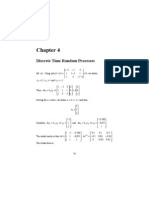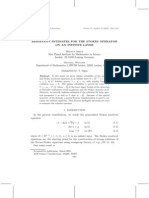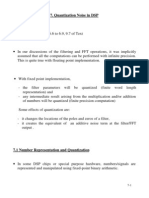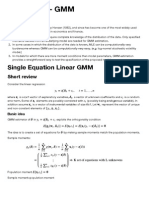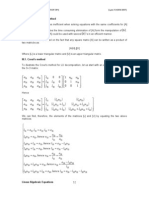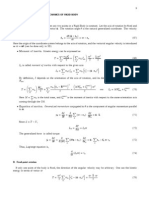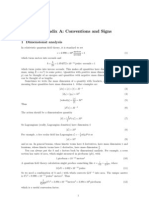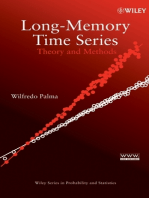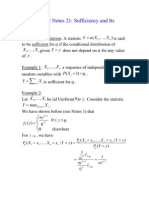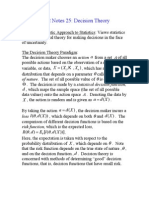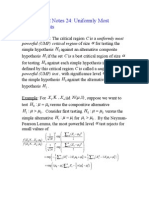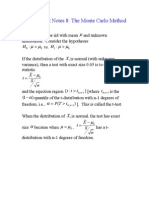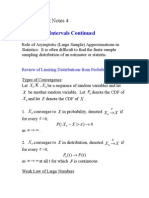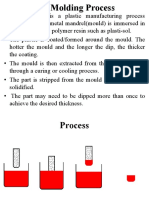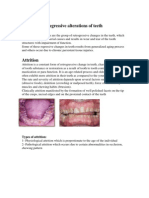Statistics 512 Notes 18
Uploaded by
Sandeep SinghStatistics 512 Notes 18
Uploaded by
Sandeep SinghStatistics 512 Notes 18:
Multiparameter maximum likelihood estimation
We consider
1
, ,
n
X X K
iid with pdf
( ; ), f x
where
1
( , , )
p
K
is p-dimensional.
As before,
1
1
1
1
( ) ( ; , , )
( ) log ( ) log ( ; , , )
n
i p
i
n
i p
i
L f x
l L f x
K
K
The maximum likelihood estimate is
arg max ( ) arg max ( )
MLE
L l
We can find critical points of the likelihood function by
solving the vector equation
1
1
1
2
1
( , , ) 0
( , , ) 0
( , , ) 0
p
p
p
p
l
l
l
K
K
M
K
We need to then verify that the critical point is a global
maximum.
Example 1: Normal distribution
1
, ,
n
X X K
iid
2
( , ) N
2
2
1
1
( ) 1 1
( , , ; , ) exp
2
2
n
i
n
i
x
f x x
1
1
]
,
K
2
2
1
1
( , ) log log 2 ( )
2 2
n
i
i
n
l n X
The partials with respect to
and
are
2
1
3 2
1
1
( )
( )
n
i
i
n
i
i
l
X
l n
X
Setting the first partial equal to zero and solving for the
mle, we obtain
MLE
X
Setting the second partial equal to zero and substituting the
mle for
, we find that the mle for
is
2
1
1
( )
n
MLE i
i
X X
n
.
To verify that this critical point is a maximum, we need to
check the following second derivative conditions:
(1) The two second-order partial derivatives are negative:
2
2
,
0
MLE MLE
l
<
and
2
2
,
0
MLE MLE
l
<
(2) The Jacobian of the second-order partial derivatives is
positive,
2 2
2
2 2
2
,
0
MLE MLE
l l
l l
>
See additional sheet for verification of (1) and (2) for
normal distribution.
Example 2: Gamma distribution
1 /
1
, 0
( ) ( ; , )
0, elsewhere
x
x e x
f x
< <
'
[ ]
1
( , ) log ( ) log ( 1) log /
n
i i
i
l X X
The partial derivatives are
1
2
1
'( )
log log
( )
n
i
i
n
i
i
l
X
X l
1
+
1
]
1
+
1
Setting the second partial derivative equal to zero, we find
1
n
i
i
MLE
MLE
X
n
When this solution is substituted into the first partial
derivative, we obtain a nonlinear equation for the MLE of
:
1
1
'( )
log log log 0
( )
n
n
i
i
MLE i
i
X
n n n X
n
+ +
This equation cannot be solved in closed form. Newtons
method or another iterative method can be used.
digamma(x) = function in R that computes the derivative of
the log of the gamma function of x,
'( )
( )
x
x
.
uniroot(f,interval) = function in R that finds the
approximate zero of a function in the interval. There
should be only one zero and the lower and upper points of
the interval should have opposite signs.
alphahatfunc=function(alpha,xvec){
n=length(xvec);
eq=-n*digamma(alpha)-n*log(mean(xvec))+n*log(alpha)
+sum(log(xvec));
eq;
}
> alphahatfunc(.3779155,illinoisrainfall)
[1] 65.25308
> alphahatfunc(.5,illinoisrainfall)
[1] -45.27781
alpharoot=uniroot(alphahatfunc,interval=c(.377,.5),xvec=ill
inoisrainfall)
> alpharoot
$root
[1] 0.4407967
$f.root
[1] -0.004515694
$iter
[1] 4
$estim.prec
[1] 6.103516e-05
betahatmle=mean(illinoisrainfall)/.4407967
[1] 0.5090602
.4408
.5091
MLE
MLE
Consistency, asymptotic distribution and optimality of
MLE for multiparameter estimation
Theorem 6.4.1: Let
1
, ,
n
X X K
be iid with pdf
1
( ; ( , , ))
p
f x K
for . Assume the regularity
conditions (R6-R9) hold [similar to (R0)-(R5), assumptions
that the log likelihood is smooth]. Then
(a)
P
MLE
(b)
1
( ) (0, ( ))
D
n p
n N I
where
( ) I
is the Fisher information matrix of ,
1
( ) log ( ; ), , log ( ; )
p
I Cov f x f x
_
,
K
.
As in the univariate case, the Fisher information matrix can
be expressed in terms of the second derivative of the log
likelihood function under the regularity conditions:
2
log ( ; ), log ( ; ) log ( ; )
jk
j k j k
I Cov f X f X E f X
_ 1
1
1
, ]
Corollary 6.4.1: Let
1
, ,
n
X X K
be iid with pdf
1
( ; ( , , ))
p
f x K
for . Assume the regularity
conditions (R6-R9) hold. Then
MLE
is an asymptotically
efficient estimate in the sense that the covariance matrix of
any other consistent estimate is at least as large (in
particular, the variance for each component of is at least
as large).
Note on practical use of theorem:
It is also true that
( )( ) (0, identity matrix)
D
MLE n p
nI N
Thus,
1
0
( ) , ( )
0
MLE MLE
N I
_ _
, ,
M
, which can be used to form
approximate confidence intervals.
Example 1:
1
, ,
n
X X K
iid
2
( , ) N .
2
2 4
2
,
2
4 4 6
1 1
- ( )
( , )
1 1 1
- ( ) ( )
2
X
I E
X X
1
1
1
1
1
]
=
2
2
1
0
2
0
1
1
1
1
1
]
Thus,
2
1 2
2
0
( , )
0
2
I
1
1
1
1
]
Thus,
2
2
0
( , ) ,
0
2
MLE MLE
n
N
n
_
1
1
_
1
1
,
1
]
,
To form approximate confidence intervals in practice, we
can substitute the MLE estimates into the covariance
matrix:
2
2
0
( , ) ,
0
2
MLE
MLE MLE
MLE
n
N
n
_
1
1
_
1
1
,
1
]
,
Thus, an approximate 95% confidence interval for
is
1.96
MLE
n
t
and an approximate 95% confidence interval
for
is
1.96
2
MLE
n
t
.
Example 2:
Gamma distribution:
( )
( )
( )
( )
2
2
,
2 3
2
2
2
''( ) ( ) '( )
1
-
( )
( , )
1 2
-
''( ) ( ) '( )
1
( )
1
I E
X
1
+
1
1
1
1
1
]
1
1
1
1
1
1
]
For the Illinois rainfall data,
.4408
.5091
MLE
MLE
Thus,
( )
( )
2
2
2
''(.4408) (.4408) '(.4408)
1
.5091
(.4408)
( , )
1 .4408
.5091 .5091
6.133 1.964
1.964 1.701
MLE MLE
I
1
1
1
1
1
1
]
1
1
]
infmat=matrix(c(6.133,1.964,1.964,1.704),ncol=2)
> invinfmat=solve(infmat)
> invinfmat
[,1] [,2]
[1,] 0.2584428 -0.2978765
[2,] -0.2978765 0.9301816
Thus,
0.259 -0.298
0
227 227
( , ) ,
0 0.298 0.259
227 227
MLE MLE
N
_
1
1
_
1
, 1
1
]
,
Thus, approximate 95% confidence intervals for
and
are
0.259
: 0.441 1.96 (0.375, 0.507)
227
0.930
: 0.509 1.96 (0.384, 0.634)
227
t
t
Note: We can also use observed Fisher information to form
confidence intervals based on maximum likelihood
estimates where in place of the information matrix, we use
the observed information matrix O where
2
1
log ( )
MLE
n
i
ij
i
i j
f X
O
We could also use the parametric bootstrap to form
confidence intervals based on maximum likelihood
estimates where we resample from
( ; )
MLE
f x
You might also like
- MUST TO KNOW CC RODRIGUEZ Flashcards - QuizletNo ratings yetMUST TO KNOW CC RODRIGUEZ Flashcards - Quizlet32 pages
- Statistics 512 Notes 16: Efficiency of Estimators and The Asymptotic Efficiency of The MLENo ratings yetStatistics 512 Notes 16: Efficiency of Estimators and The Asymptotic Efficiency of The MLE6 pages
- Discrete Time Random Processes: 4.1 (A) UsingNo ratings yetDiscrete Time Random Processes: 4.1 (A) Using16 pages
- Review: Generalized Least Squares: 3.1. Covariance MatricesNo ratings yetReview: Generalized Least Squares: 3.1. Covariance Matrices12 pages
- A New Formulation For Empirical Mode Decomposition Based On Constrained OptimizationNo ratings yetA New Formulation For Empirical Mode Decomposition Based On Constrained Optimization10 pages
- Bias-Variance Tradeoffs: 1 Single Sample MLENo ratings yetBias-Variance Tradeoffs: 1 Single Sample MLE7 pages
- 127 - PR 02 - Decay of A Scalar ParticleNo ratings yet127 - PR 02 - Decay of A Scalar Particle7 pages
- Resolvent Estimates For The Stokes Operator On An Infinite LayerNo ratings yetResolvent Estimates For The Stokes Operator On An Infinite Layer30 pages
- Derivative of Arcsecant (Why The Absolute Value)No ratings yetDerivative of Arcsecant (Why The Absolute Value)4 pages
- The Problem: Library (MASS) Data (Faithful) Attach (Faithful)No ratings yetThe Problem: Library (MASS) Data (Faithful) Attach (Faithful)7 pages
- Tetrad Formulation of The Einstein Field Equations: The Newman-Penrose EquationsNo ratings yetTetrad Formulation of The Einstein Field Equations: The Newman-Penrose Equations16 pages
- Research Progress: 1 Lorentz TransformationsNo ratings yetResearch Progress: 1 Lorentz Transformations9 pages
- Fourier Series, Discrete Fourier Transforms and Fast Fourier TransformsNo ratings yetFourier Series, Discrete Fourier Transforms and Fast Fourier Transforms6 pages
- A Sequential Linear Programming Method For Generalized Linear Complementarity ProblemNo ratings yetA Sequential Linear Programming Method For Generalized Linear Complementarity Problem8 pages
- Some Applications Involving Binary Data: (A) Comparison of Two Binomial ProbabilitiesNo ratings yetSome Applications Involving Binary Data: (A) Comparison of Two Binomial Probabilities7 pages
- Key Words and Phrases. Primes, Inequalities, AGM-InequalityNo ratings yetKey Words and Phrases. Primes, Inequalities, AGM-Inequality6 pages
- Mario R. Melchiori CPA Universidad Nacional Del Litoral Santa Fe - ArgentinaNo ratings yetMario R. Melchiori CPA Universidad Nacional Del Litoral Santa Fe - Argentina8 pages
- On Some Smarandache Determinant SequencesNo ratings yetOn Some Smarandache Determinant Sequences16 pages
- معامل الارتباط بين المركب الرئيسي والمتغير العشوائيNo ratings yetمعامل الارتباط بين المركب الرئيسي والمتغير العشوائي2 pages
- MATH 437/ MATH 535: Applied Stochastic Processes/ Advanced Applied Stochastic ProcessesNo ratings yetMATH 437/ MATH 535: Applied Stochastic Processes/ Advanced Applied Stochastic Processes7 pages
- Coherent States of The Harmonic Oscillator: 1. What Is A Coherent State ?No ratings yetCoherent States of The Harmonic Oscillator: 1. What Is A Coherent State ?7 pages
- Quantum Physics III (8.06) Spring 2008 Solution Set 10: ψ (x) = (k/a + i tanh (ax) ) eNo ratings yetQuantum Physics III (8.06) Spring 2008 Solution Set 10: ψ (x) = (k/a + i tanh (ax) ) e7 pages
- Mean Value of A Smarandache-Type FunctionNo ratings yetMean Value of A Smarandache-Type Function4 pages
- Appendix A: Conventions and Signs: 1 Dimensional AnalysisNo ratings yetAppendix A: Conventions and Signs: 1 Dimensional Analysis4 pages
- Student Solutions Manual to Accompany Economic Dynamics in Discrete Time, secondeditionFrom EverandStudent Solutions Manual to Accompany Economic Dynamics in Discrete Time, secondedition4.5/5 (2)
- Statistics 512 Notes 26: Decision Theory Continued: FX FX DNo ratings yetStatistics 512 Notes 26: Decision Theory Continued: FX FX D11 pages
- Statistics 512 Notes 25: Decision Theory: of Nature. The Set of All Possible Value ofNo ratings yetStatistics 512 Notes 25: Decision Theory: of Nature. The Set of All Possible Value of11 pages
- Statistics 512 Notes 24: Uniformly Most Powerful Tests: X FX X FX X XNo ratings yetStatistics 512 Notes 24: Uniformly Most Powerful Tests: X FX X FX X X7 pages
- Statistics 512 Notes 12: Maximum Likelihood Estimation: X X PX XNo ratings yetStatistics 512 Notes 12: Maximum Likelihood Estimation: X X PX X5 pages
- Statistics 512 Notes 8: The Monte Carlo Method: X X H H X Is Normal (With UnknownNo ratings yetStatistics 512 Notes 8: The Monte Carlo Method: X X H H X Is Normal (With Unknown7 pages
- Confidence Intervals Continued: Statistics 512 Notes 4No ratings yetConfidence Intervals Continued: Statistics 512 Notes 48 pages
- Frequently Used Equations - The Physics HypertextbookNo ratings yetFrequently Used Equations - The Physics Hypertextbook4 pages
- Computer Science Project On Java LanguageNo ratings yetComputer Science Project On Java Language163 pages
- 31 10 11 560931 10 11 8140C 09 - Oct Nov 2011No ratings yet31 10 11 560931 10 11 8140C 09 - Oct Nov 201125 pages
- YARVIK XENTA 9.7 - TAB09-211 - Manual - MultilingualNo ratings yetYARVIK XENTA 9.7 - TAB09-211 - Manual - Multilingual452 pages
- MDCT: Technical Principles and Future Trends: Mathias ProkopNo ratings yetMDCT: Technical Principles and Future Trends: Mathias Prokop8 pages
- Unmanned Level Crossing Controller and Rail Track Broken Detection System Using IR Sensors and Internet of Things TechnologyNo ratings yetUnmanned Level Crossing Controller and Rail Track Broken Detection System Using IR Sensors and Internet of Things Technology5 pages
- Elementary Number Theory Homework Solutions100% (1)Elementary Number Theory Homework Solutions5 pages
- Systemized Orthodontic Treatment Mechanics100% (1)Systemized Orthodontic Treatment Mechanics312 pages
- Test Frequency and Acceptance Criteria: Subgrade/Shoulder/Median75% (4)Test Frequency and Acceptance Criteria: Subgrade/Shoulder/Median6 pages
- Electrical Wiring Installation Guide MPDNo ratings yetElectrical Wiring Installation Guide MPD10 pages
- Vanna Venturi House: "Non Sequitur" and "Duality" in ArchitectureNo ratings yetVanna Venturi House: "Non Sequitur" and "Duality" in Architecture8 pages
- Economic Methodology Is The Study of MethodsNo ratings yetEconomic Methodology Is The Study of Methods18 pages
- Statistics 512 Notes 16: Efficiency of Estimators and The Asymptotic Efficiency of The MLEStatistics 512 Notes 16: Efficiency of Estimators and The Asymptotic Efficiency of The MLE
- Review: Generalized Least Squares: 3.1. Covariance MatricesReview: Generalized Least Squares: 3.1. Covariance Matrices
- A New Formulation For Empirical Mode Decomposition Based On Constrained OptimizationA New Formulation For Empirical Mode Decomposition Based On Constrained Optimization
- Resolvent Estimates For The Stokes Operator On An Infinite LayerResolvent Estimates For The Stokes Operator On An Infinite Layer
- The Problem: Library (MASS) Data (Faithful) Attach (Faithful)The Problem: Library (MASS) Data (Faithful) Attach (Faithful)
- Tetrad Formulation of The Einstein Field Equations: The Newman-Penrose EquationsTetrad Formulation of The Einstein Field Equations: The Newman-Penrose Equations
- Fourier Series, Discrete Fourier Transforms and Fast Fourier TransformsFourier Series, Discrete Fourier Transforms and Fast Fourier Transforms
- A Sequential Linear Programming Method For Generalized Linear Complementarity ProblemA Sequential Linear Programming Method For Generalized Linear Complementarity Problem
- Some Applications Involving Binary Data: (A) Comparison of Two Binomial ProbabilitiesSome Applications Involving Binary Data: (A) Comparison of Two Binomial Probabilities
- Key Words and Phrases. Primes, Inequalities, AGM-InequalityKey Words and Phrases. Primes, Inequalities, AGM-Inequality
- Mario R. Melchiori CPA Universidad Nacional Del Litoral Santa Fe - ArgentinaMario R. Melchiori CPA Universidad Nacional Del Litoral Santa Fe - Argentina
- معامل الارتباط بين المركب الرئيسي والمتغير العشوائيمعامل الارتباط بين المركب الرئيسي والمتغير العشوائي
- MATH 437/ MATH 535: Applied Stochastic Processes/ Advanced Applied Stochastic ProcessesMATH 437/ MATH 535: Applied Stochastic Processes/ Advanced Applied Stochastic Processes
- Coherent States of The Harmonic Oscillator: 1. What Is A Coherent State ?Coherent States of The Harmonic Oscillator: 1. What Is A Coherent State ?
- Quantum Physics III (8.06) Spring 2008 Solution Set 10: ψ (x) = (k/a + i tanh (ax) ) eQuantum Physics III (8.06) Spring 2008 Solution Set 10: ψ (x) = (k/a + i tanh (ax) ) e
- Appendix A: Conventions and Signs: 1 Dimensional AnalysisAppendix A: Conventions and Signs: 1 Dimensional Analysis
- Student Solutions Manual to Accompany Economic Dynamics in Discrete Time, secondeditionFrom EverandStudent Solutions Manual to Accompany Economic Dynamics in Discrete Time, secondedition
- A-level Maths Revision: Cheeky Revision ShortcutsFrom EverandA-level Maths Revision: Cheeky Revision Shortcuts
- Statistics 512 Notes 26: Decision Theory Continued: FX FX DStatistics 512 Notes 26: Decision Theory Continued: FX FX D
- Statistics 512 Notes 25: Decision Theory: of Nature. The Set of All Possible Value ofStatistics 512 Notes 25: Decision Theory: of Nature. The Set of All Possible Value of
- Statistics 512 Notes 24: Uniformly Most Powerful Tests: X FX X FX X XStatistics 512 Notes 24: Uniformly Most Powerful Tests: X FX X FX X X
- Statistics 512 Notes 12: Maximum Likelihood Estimation: X X PX XStatistics 512 Notes 12: Maximum Likelihood Estimation: X X PX X
- Statistics 512 Notes 8: The Monte Carlo Method: X X H H X Is Normal (With UnknownStatistics 512 Notes 8: The Monte Carlo Method: X X H H X Is Normal (With Unknown
- Confidence Intervals Continued: Statistics 512 Notes 4Confidence Intervals Continued: Statistics 512 Notes 4
- Frequently Used Equations - The Physics HypertextbookFrequently Used Equations - The Physics Hypertextbook
- YARVIK XENTA 9.7 - TAB09-211 - Manual - MultilingualYARVIK XENTA 9.7 - TAB09-211 - Manual - Multilingual
- MDCT: Technical Principles and Future Trends: Mathias ProkopMDCT: Technical Principles and Future Trends: Mathias Prokop
- Unmanned Level Crossing Controller and Rail Track Broken Detection System Using IR Sensors and Internet of Things TechnologyUnmanned Level Crossing Controller and Rail Track Broken Detection System Using IR Sensors and Internet of Things Technology
- Test Frequency and Acceptance Criteria: Subgrade/Shoulder/MedianTest Frequency and Acceptance Criteria: Subgrade/Shoulder/Median
- Vanna Venturi House: "Non Sequitur" and "Duality" in ArchitectureVanna Venturi House: "Non Sequitur" and "Duality" in Architecture






